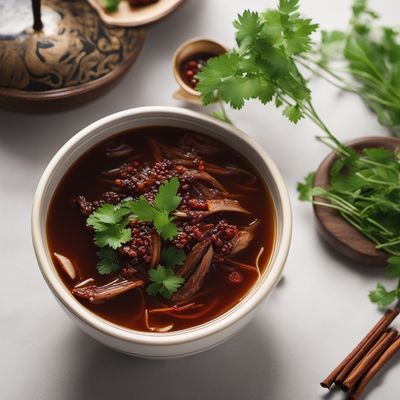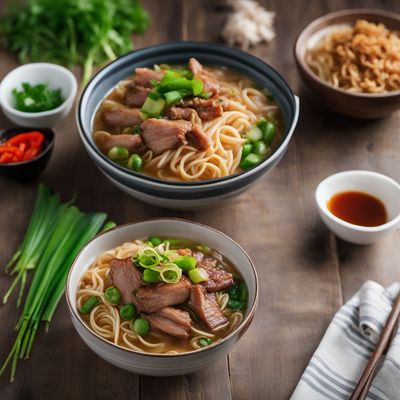
Ingredient
Fresh egg pasta
The Art of Homemade Pasta
Fresh egg pasta is a classic Italian staple, made by combining eggs and flour to create a smooth and elastic dough. It has a delicate and tender texture, with a rich flavor that enhances the taste of various sauces and fillings. This homemade pasta is a labor of love, requiring skill and patience to achieve the perfect consistency.
Origins and history
Fresh egg pasta has its roots in Italy, where it has been a culinary tradition for centuries. The art of making pasta by hand has been passed down through generations, with each region having its own unique variations and techniques. Fresh egg pasta is deeply ingrained in Italian culture and is a symbol of homemade goodness and craftsmanship.
Nutritional information
Fresh egg pasta is a good source of carbohydrates and protein, providing energy and essential amino acids. It also contains vitamins and minerals, such as vitamin A, iron, and selenium. However, it is important to note that the nutritional content may vary depending on the specific recipe and serving size.
Allergens
Egg pasta may contain allergens such as eggs and wheat, which can cause allergic reactions in some individuals. It is not suitable for those with egg or gluten intolerances or allergies.
How to select
When selecting fresh egg pasta, look for a vibrant yellow color, indicating a high egg content. The pasta should feel smooth and slightly tacky to the touch, without any dry or cracked edges. Opt for artisanal or homemade options for the best quality and flavor.
Storage recommendations
To maintain the freshness of fresh egg pasta, store it in the refrigerator in an airtight container or wrapped tightly in plastic wrap. It is best consumed within a few days of preparation to ensure optimal taste and texture. Avoid freezing fresh egg pasta, as it can affect its quality and texture.
How to produce
Producing fresh egg pasta requires a combination of skill and practice. The dough is made by mixing eggs and flour, then kneading it until smooth and elastic. It is then rolled out and cut into various shapes, such as fettuccine, tagliatelle, or ravioli. Homemade pasta machines or pasta rollers can aid in achieving consistent thickness and shape.
Preparation tips
Fresh egg pasta can be cooked in boiling salted water until al dente, typically within a few minutes. It pairs well with a variety of sauces, from simple tomato-based sauces to creamy Alfredo or pesto. It can also be used to create lasagna, cannelloni, or stuffed pasta dishes.
Substitutions
Fresh egg pasta can be substituted with dried pasta, although the texture and flavor will differ. Alternatively, gluten-free pasta made from rice, corn, or quinoa can be used as a substitute for those with dietary restrictions.
Culinary uses
Fresh egg pasta is a staple in Italian cuisine and is used in a wide range of dishes, including classics like spaghetti carbonara, fettuccine Alfredo, and lasagna. It is also commonly used in filled pasta dishes, such as ravioli and tortellini.
Availability
Fresh egg pasta is widely available in Italy and can be found in most grocery stores, markets, and specialty pasta shops. It is also popular in other countries with a strong Italian culinary influence.
More ingredients from this category
Recipes using Fresh egg pasta » Browse all

Grenadian Spice-infused Devils on Horseback
Spicy Grenadian Delights: Devils on Horseback with a Caribbean Twist

Telugu-style Kofta Curry
Spicy and Flavorful Kofta Curry with a Telugu Twist

Bengali-style Stuffed Buns
Savory Delights: Bengali-inspired Stuffed Buns

Polish-style Chicken Korma
Creamy Chicken Delight: A Polish Twist on Indian Korma

Refreshing Spicy Jelly Noodles
Chilled Delight: Spicy Liangfen Noodles

Bangladeshi-style Spicy Chicken with Nam Chim Sauce
Fiery Bangladeshi Chicken with Tangy Nam Chim Sauce

Guangxi-style Duck Blood Soup
Savory Delight: Guangxi-style Duck Blood Soup

Zardak Kebab with Spiced Lamb and Fragrant Rice
Saffron-infused Delight: Zardak Kebab with Fragrant Rice

New York City Kinpira
Big Apple Kinpira: A Spicy Twist on Japanese Delight

Cârnaţi de Pleşcoi with Smoky Paprika Sauce
Sizzling Pleşcoi Sausages with a Fiery Twist

Japanese Curry with Chicken and Vegetables
Savory Delight: Japanese Curry Infused with Fragrant Spices

Batchoy Soup
Savory Pork Noodle Soup: A Filipino Delight
